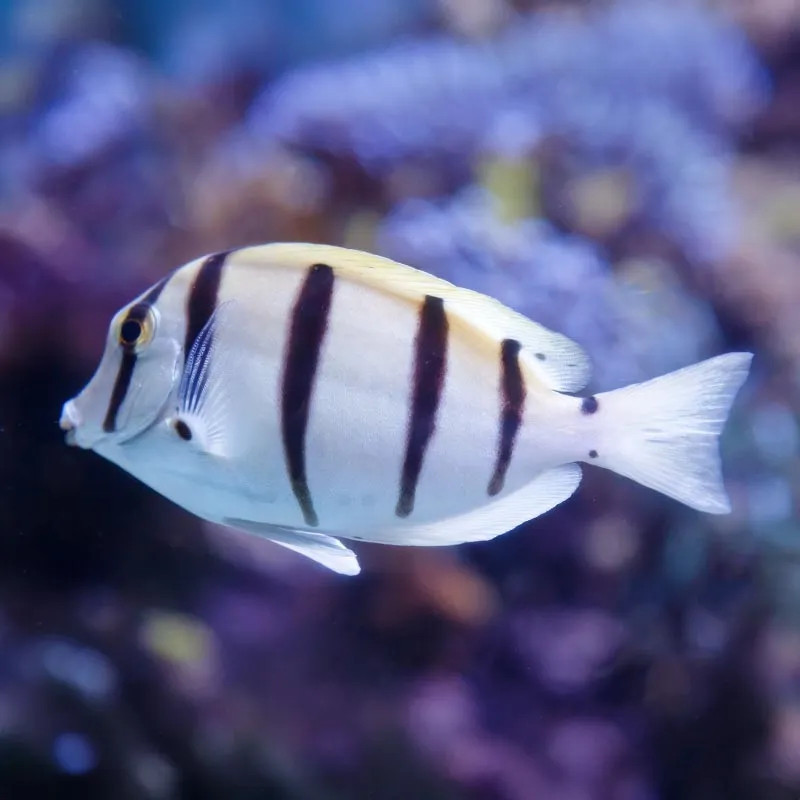Introduction
- Common Name: Convict Tang
- Native Habitat: Found in the coral reefs of the Indo-Pacific region, including areas like the Hawaiian Islands, the Great Barrier Reef, and parts of the Indian Ocean.
Physical Characteristics
- Appearance: The Convict Tang is easily recognized by its striking coloration, featuring bold vertical black stripes on a light yellow or white body. This distinctive pattern gives it the nickname "Convict Tang."
- Size: Adults typically grow to a length of 6 to 8 inches (15 to 20 cm).
- Fins: The Convict Tang has a robust dorsal fin that contributes to its streamlined swimming capabilities.
Habitat Requirements
- Tank Size: A minimum of 75 gallons is recommended to accommodate their active swimming habits and territorial nature.
- Water Conditions:
- Temperature: Thrives in warmer waters, ideally between 75°F to 82°F (24°C to 28°C).
- pH Level: Prefers a slightly alkaline pH range of 8.1 to 8.4.
- Hardness: Water hardness of 8 to 12 dGH is suitable.
- Aquascaping: The tank should be well-decorated with live rock, coral formations, and ample swimming space to mimic their natural environment.
Diet
- Feeding Habits: Convict Tangs are herbivorous, primarily grazing on algae in their natural habitat. They play a key role in controlling algae growth on reefs.
- Dietary Options: In captivity, they should be offered a varied diet of high-quality marine algae, spirulina-based foods, and specially formulated herbivore pellets. Occasional offerings of leafy greens like nori or lettuce are also beneficial.
- Feeding Frequency: Feed once or twice a day, ensuring sufficient food is provided to prevent aggression among tank mates.
Compatibility
- Temperament: Semi-aggressive; Convict Tangs can be territorial, especially in smaller tanks or during breeding seasons.
- Tank Mates: Can coexist with other semi-aggressive fish, such as larger wrasses, angelfish, and certain species of triggers.
- Incompatibilities: Avoid pairing with smaller, peaceful fish or other tangs, as they may become targets for aggression.
Care Level
- Difficulty: Moderate; best suited for aquarists with some experience due to their specific care needs and territorial behavior.
- Health Monitoring: Regular water changes and monitoring of water parameters are essential to maintain a stable environment and prevent disease.
Breeding
- Breeding Behavior: Little is known about breeding Convict Tangs in captivity. They are believed to spawn in the water column during the breeding season, releasing eggs.
- Fry Care: Raising fry is challenging and typically requires specialized care, which is difficult to replicate in home aquariums.
Economic Considerations
- Market Demand: The Convict Tang is popular in the aquarium trade for its striking appearance and ecological role.
- Wholesale Pricing: Prices vary based on size and availability, generally falling within the moderate to higher-end range.
- Retail Pricing: Available at marine specialty stores and online, buyers should seek healthy specimens from reputable sources.
Sustainability and Conservation
- Wild Population: While not considered endangered, their populations are threatened by habitat destruction and overfishing.
- Aquaculture: Some Convict Tangs are bred in captivity, but the majority are wild-caught, highlighting the importance of sustainable fishing practices.
Conclusion
The Convict Tang is a visually striking and active species that can bring beauty and balance to any marine aquarium. With proper care, suitable tank mates, and a healthy environment, these tangs can thrive, contributing to the health and aesthetic appeal of reef ecosystems.
